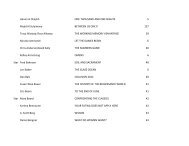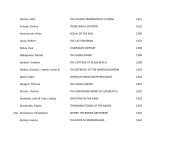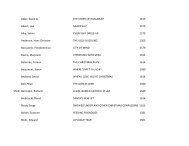nonfiction
nonfiction
nonfiction
Create successful ePaper yourself
Turn your PDF publications into a flip-book with our unique Google optimized e-Paper software.
“A slightly buggy but<br />
enticing introduction to philosophy…”<br />
from let the thinking begin!<br />
interactive e-books<br />
AESOP’S TALES<br />
Aesop<br />
Translated by Hedley, Emma<br />
Progetto Rosetta<br />
$2.99 | Feb. 4, 2012<br />
1.0; Feb. 4, 2012<br />
Shoddy, sloppy and badly translated,<br />
this collection of five fables is as baffling<br />
as it is crude.<br />
Apparently “[translated] from Ancient Greek” by Casanova<br />
into Italian and then translated into English, according to the credits<br />
page, this collection includes short, lightly animated versions of<br />
“The Fox and the Grapes,” “The Grasshopper and the Ants,” “The<br />
Lion and the Dolphin,” “The Fox and the Crow” and “The Tortoise<br />
and the Hare.” There’s no voice narration, which is a blessing,<br />
given the clunky, near-indecipherable text that accompanies each<br />
story. The conclusion of “The Fox and the Grapes,” for instance,<br />
offers this stunner of a garbled moral: “Those who do not succeed<br />
in realising their aims because they are not able to do so, often disdain<br />
that which they did not succeed in doing.” Good luck parsing<br />
that one, kids. Most disturbingly, each tale of wretched animals in<br />
moral quandaries ends with a near-naked old man (Aesop, presumably)<br />
whom readers must dress in order to unlock the moral. The<br />
old man shows up five times in five separate states of partial nudity,<br />
leaving readers to wonder if he may have a serious problem. Even<br />
apart from these significant problems, the app also suffers from<br />
poor navigation, lackluster artwork and leaps of logic too big to<br />
ignore even for a fanciful children’s app. For the record, lions and<br />
dolphins cannot shake hands.<br />
It’s a mess, riddled with typos, botched wording and<br />
grating sound cues. The moral here is obvious: The person<br />
who fails to steer clear of this app will find much to regret.<br />
(iPad storybook app. 3-6)<br />
THE COMET<br />
Baldassarre, Ivano<br />
Translated by Bianchi, Emma<br />
Illus. by Glioti, Andrea<br />
bitLuna<br />
$1.99 | Feb. 13, 2012<br />
1.0; Feb. 13, 2012<br />
Three kids—Anna, Gino and Mark—<br />
are stressed out by the demands of modern<br />
student life and the distractions of the digital age. Their<br />
lives are therefore improved when a passing comet renders all<br />
the technology in their town of Sourapple useless.<br />
The friends find that they’d rather go outside, making out<br />
shapes from clouds and playing hide and seek. It’s a nice message,<br />
shown in simplified, modern cartoon art and well-executed sound<br />
effects that represent many of our modern conveniences as annoying,<br />
bleating boxes. The app’s art style and sprightly interactive elements<br />
are nearly enough to make readers forget that every page<br />
is burdened with far too much redundant, overwritten text. Mark,<br />
for instance, “was a busy bee! He had school in the mornings, followed<br />
by afternoon lessons for violin, swimming and French. Not<br />
to forget football training and his school homework of course!”<br />
The English narrator is a young boy, an effect that is charming at<br />
first, then increasingly grating as the text goes on and on (and on).<br />
There’s also a set of navigation icons that, confusingly, move to different<br />
parts of the page depending on the scene. The app is stuffed<br />
with extras, from coloring pages to videos; “The Comet Song,” presented<br />
with lyrics, is as catchy as it is endless.<br />
The irony of a story about digital distraction presented<br />
on the iPad won’t be lost on readers, and, like a lot of the technology<br />
we have that’s unaffected by passing comets, the app<br />
itself is a bit of a mixed blessing. (iPad storybook app. 3-7)<br />
BUFO’S MUSIC<br />
Baldisserotto, Zak<br />
Illus. by Zeta, Roberta<br />
Kite Edizioni Srl<br />
$4.99 | Feb. 19, 2012<br />
1.2; Feb. 19, 2012<br />
Music changes a toad’s life.<br />
Poor, sweet Bufo. For a toad he’s just<br />
flat out of luck. With slow reflexes and bad<br />
eyesight, he’s the butt of all the other toads’ jokes. But one day, in<br />
a chance meeting with some musical insects, Bufo begins a leap of<br />
discovery that changes everything. This tender toad story engages<br />
from the get-go, with original music throughout, Zeta’s textured,<br />
childlike illustrations and interactive bonbons on every page.<br />
Toads leap and catch dragonflies; stars twinkle and have songs of<br />
their own; a virtual chorus of insects provides its own soundtrack.<br />
Although the narrative is amateurishly written and runs a bit textheavy<br />
at times, there’s plenty to slide, tap, swipe and move around<br />
on the pages of Bufo’s world, so his story doesn’t lose momentum.<br />
Clever, well-timed sound effects enhance the story, and the navigation<br />
is swing-in-a-hammock easy.<br />
All toads considered, this is a story for the misfit in all<br />
of us. (iPad storybook app. 3-8)<br />
THE GARDEN OF EDEN<br />
BelugaBloo<br />
BelugaBloo<br />
$1.99 | Feb. 21, 2012<br />
1.0; Feb. 21, 2012<br />
Another ho-hum, didactic Bible<br />
story warning kids about the dangers of<br />
disobedience.<br />
This adaptation of the Genesis passage<br />
about the Garden of Eden sticks pretty close to the Biblical<br />
text. God creates Adam and Eve. One day Eve is picking fruit<br />
for dinner and meets an “evil talking snake” that aims to “ruin<br />
all good things!” Wanting to be as powerful as God is, Eve takes<br />
home a forbidden apple for dinner and God eventually punishes<br />
the couple for eating what they weren’t supposed to. The<br />
overall visual aesthetic is quite pleasant, with bold, collagelike<br />
illustrations that burst with color. Unfortunately, aside from a<br />
loop of Mozart’s Eine Kleine Nachtmusik, that’s about all this app<br />
has to offer in terms of creativity and distinctiveness. Interactions<br />
consist of a few animals and clouds that barely move when<br />
tapped or swiped (indicated by blinking yellow arrows) and one<br />
page where Adam can be softly ricocheted around the screen.<br />
When they realize they’re unclothed (sans anatomically correct<br />
body parts) they exclaim, “ewww [sic]! You’re naked!” and “Go<br />
put some clothes on!” In “read by myself ” mode, each screen<br />
opens with a crumpled sheet of paper covered in text, which<br />
disappears when tapped, revealing the illustration. There are<br />
also autoplay and “read to me” options.<br />
Preachy, homogenous and bland. (iPad storybook app. 2-5)<br />
A FRIEND TO THE RESCUE<br />
Carson, David<br />
Illus. by Carson, David<br />
Jolly Bubble<br />
$1.99 | Mar. 3, 2012<br />
1.0; Mar. 3, 2012<br />
Written over a decade ago when<br />
the author was 10 and evidently never<br />
revised, this aquatic app sinks under the<br />
combined weight of clumsy prose and a severely limited suite of<br />
rudimentary special effects.<br />
The plot is rudimentary too. With help from a sea turtle and<br />
other friends (plural in the story, if not the title), a lost baby whale<br />
eludes sharks by hiding behind a “giant piece of corral [sic],” then<br />
rejoins his mother at last. In each sparely detailed cartoon scene,<br />
tapping five buttons shaped like shells or other sea life will cause<br />
as many random nautical facts to drop into view. These range<br />
from the uselessly broad “50-80% of all life on earth [sic] is found<br />
in the ocean,” to an awkwardly phrased claim that the “deepest<br />
spot in the ocean is the Mariana Trench and is approximately<br />
35,797 feet deep in the Pacific Ocean.” Tapping anywhere else on<br />
any screen causes bubbles to appear with loud bloops, which is<br />
the only other interactive feature. There is no audio narration or<br />
music, nor options for paging backward or even for starting over.<br />
Extensive editing and a major software upgrade might<br />
raise this wreck, but it will take more than that to keep it<br />
afloat. (iPad storybook/informational app. 6-8)<br />
WORLD ATLAS<br />
Crane, Nick<br />
Illus. by Dean, David<br />
Barefoot Books<br />
$7.99 | Mar. 15, 2012<br />
1.1.0; Mar. 15, 2012<br />
Animations and clever enhancements<br />
give this elementary atlas more flash than<br />
its print version (2011), but the content<br />
remains skimpy and poorly organized.<br />
Built around a really quite cool cartoon globe that can be<br />
rotated at will, the app allows viewers to zoom in on any area or<br />
country. A tap opens a fact box that contains an animated national<br />
flag, basic information such as land area, capital city and (with<br />
location settings turned on) “Distance From Me.” There is also<br />
a handful of environmental facts such as average CO2 emissions<br />
per head and current weather (presumably in said capital). Audio<br />
narration and a snatch of localized music are optionally available<br />
as well. Alternatively, countries or world regions can also be<br />
selected through searchable lists linked to a corner icon or visited<br />
alphabetically using arrows at the bottom. In addition, tapping<br />
on any of the dozens of small buildings, flora or fauna, objects and<br />
human figures that festoon the globe opens a box with a link to<br />
a photo and an assortment of facts, albeit not always clearly presented<br />
ones. The “Brahman cattle” icon, for instance, indicates<br />
that though they are “[o]riginally from India, these cattle are now<br />
popular around the world,” without explaining exactly why it’s<br />
wandering across Brazil. There are no political boundaries except<br />
for country borders, and those are hard to find even at full zoom.<br />
Not useful for reference, though an enticing plaything<br />
for younger armchair travelers. (iPad informational app. 5-8)<br />
LET THE THINKING BEGIN!<br />
Leask, Amy<br />
Illus. by Hughes, Mark<br />
Enable Training and Consulting, Inc.<br />
$3.99 | Dec. 9, 2011<br />
1.0; Dec. 9, 2011<br />
A slightly buggy but enticing introduction<br />
to philosophy, based on the first of a<br />
print series published in Canada (2011).<br />
Squired by Sophia, an extroverted child resembling Dora the<br />
Explorer, young enquirers not only get exposure to broad definitions<br />
and basic ground rules for “Doing Philosophy”—meaning<br />
thinking about or discussing important ideas in systematic, civilized<br />
ways—but considerable drilling down into the topic, too. She<br />
lays out the purviews of metaphysics, epistemology, ethics and<br />
other branches of the discipline in simple but specific language.<br />
This is followed by introductions to five prominent practitioners<br />
(“Hannah Arendt here, and boy, oh boy, did I learn a lot of important<br />
things from philosophy!”) with overviews of their distinctive<br />
“fave subjects.” The app closes with a list of 13 brain benders<br />
like “What does it mean for something to be ‘normal’” Aside<br />
from two screens of appended historical and geographical sliders<br />
880 | 15 april 2012 | children’s & teen | kirkusreviews.com |<br />
| kirkusreviews.com | children’s & teen | 15 april 2012 | 881






